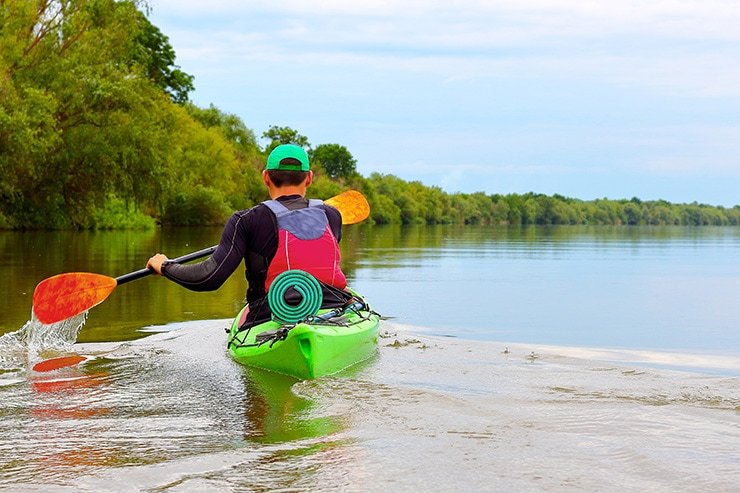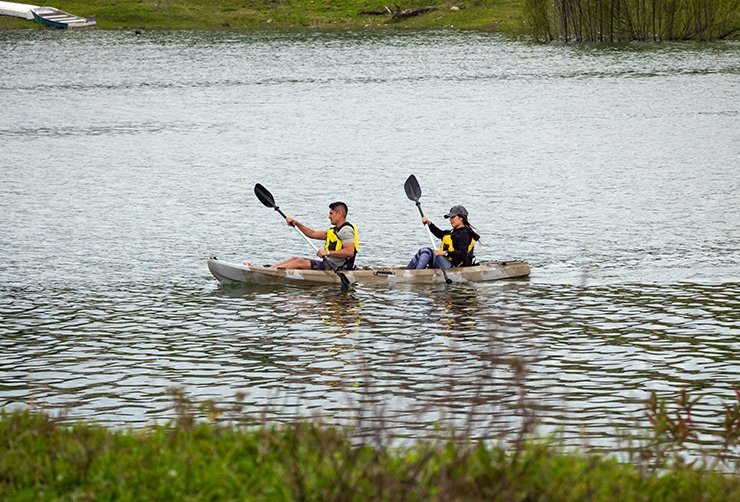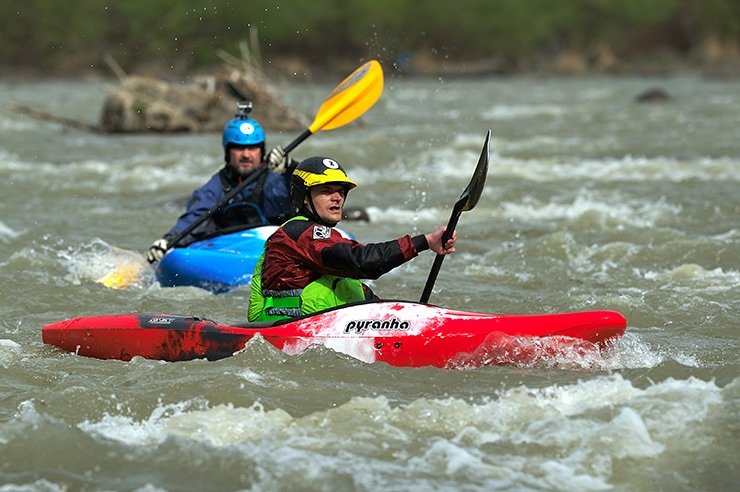When getting into a new activity you’ll sometimes come across terms you don’t quite understand. It’s no different with kayaking. One of the terms that newbies may not understand is “tracking”.
What does tracking mean in kayaking? Tracking is your kayak’s ability to go in a straight line.
You see, even though there aren’t roads on the water, you still want your kayak to stay on a certain path. That’s how you get to where you’re going, after all. So the ability to follow that path without going off-course is what is referred to as tracking.
Let’s get into the details of kayak tracking, what affects it, and how you can make your kayak track better.
Key Takeaways
- Tracking is the ability of a kayak to go in a straight line without going off-course.
- Weathercocking is the tendency of a kayak to turn into the wind when paddling, which can affect tracking.
- Hull design is a major factor that determines how well a kayak tracks. Long and narrow kayaks with less rocker track better than short and wide ones with more rocker.
- Rudder and skeg are accessories that can help improve tracking.
- Paddling style also influences tracking. Having the right paddle size and shape, using efficient paddle strokes, and engaging the core muscles can help kayakers paddle straight.
What It Means for Your Kayak to Track Well and Why This Matters
When someone says that a kayak tracks well, they mean that it is easy to paddle in a straight line. It doesn’t zigzag or snake making it harder for you to follow a straight path.
Why is this important?
Having a kayak that tracks well means you’ll spend less time and energy trying to correct your direction. It’s hard steering a kayak that just won’t stay the course.
Another reason why tracking matters is because a kayak that tracks well glides faster and more smoothly on the water. It will take less effort to get to where you’re going and you can cover more distance in a short time.
It’s easier and more fun.

Tracking Vs. Weathercocking in a Kayak
Like tracking, weathercocking is another term often used to describe a kayak’s performance on the water. Weathercocking is the tendency of a kayak to turn into the wind when you’re paddling.
This happens when the wind blows against the side of the kayak and it pushes the stern away, causing the bow to turn into the wind.
Even a kayak with good tracking can weathercock and give you trouble when it’s windy. But there are ways to correct it.
Factors That Affect Your Kayak’s Tracking
What determines whether or not your kayak tracks well?
The Shape of the Kayak
A long and narrow kayak with less rocker will track better than a short and wide one with more rocker.
Rocker is the curvature of a kayak from bow to stern. A kayak with more rocker looks more curved when you view it from the side–it has more of a banana shape. On the water, this kayak will have the bow and stern higher above the water. A kayak with less rocker will appear a little flat.
While making a long, narrow kayak track straight is easy, the design makes it less maneuverable and harder to turn. Shorter and wider kayaks with poorer tracking are, on the other hand, super easy to maneuver.
Paddler’s Experience
Experienced kayakers can kayak straight with pretty much any vessel, regardless of the hull design. They have mastered the right paddling techniques and their paddle strokes are more efficient. They know what to do to get good performance from different kayak designs.
Beginners may struggle a little in this area because they’re still learning. Sometimes poor tracking is not a result of the kayak’s ability but the paddler’s experience.

Water and Weather Conditions
Even with the proper kayak and good paddling skills, you may still have trouble with tracking due to the weather and water conditions, especially with the wind and currents.
I’ve talked briefly about weathercocking above. When the wind is blowing it can sway the stern and cause the bow to turn into the wind, throwing you off-course.
A strong current can also affect the tracking ability of your kayak by swaying it and making it go off the “path”.
How to Make Your Kayak Track Better
So, how do you improve tracking? Here are my top solutions.
Get the Right Kayak for Your Paddling Lifestyle
There are many things you can do with a kayak, which has led to the emergence of different kayaking disciplines (like whitewater kayaking, sea kayaking, or flatwater kayaking, for example).
This means you have to choose the right hull shape for the type of kayaking you want to do. Sea kayaks, for instance, have to be long and narrow to deliver excellent tracking. This is because sea kayaking is mostly about covering distance and you need efficient kayak tracking and remarkable speed.
READ NEXT: How Fast Is a Kayak? Average Kayak Speed Explained
Whitewater kayaks, on the other hand, are shorter with more rocker. They are extremely maneuverable and perfect for running rapids. But they will frustrate you in flatwater because of their poor tracking.
So if you want a kayak with high or good tracking, go for one with a longer and narrower hull as well as less rocker.
However, remember that with a longer hull you get tracking at the expense of maneuverability. And narrower kayaks can be unstable. So for activities like fishing on calm water, it’s important to find some balance.

Use a Rudder or Skeg
Both a rudder and a skeg can help keep your kayak on track.
A rudder is a movable accessory at the bottom of the hull, towards the stern. It’s mainly designed to help with maneuverability. Rudders are mostly controlled using foot pedals and you can use them to make your kayak turn to the left or right.
That is, you can use a rudder to steer your kayak.
A skeg is more of a retractable fin that helps keep your kayak going in a straight direction. You can deploy your skeg by extending it into the water or retracting it into the kayak when not in use.
Let’s say there’s a strong wind blowing from your side, causing your stern to turn to one side and the bow to turn into the wind (weather-cocking). You can deploy your skeg to create more wind resistance at the stern and help your kayak track straight.
If you have a rudder, you can adjust it until your stern turns back into the wind, improving your kayak tracking.
Rudders and skegs are more common in sea kayaks and touring kayaks. These kayak types are longer and more affected by the wind force, which is why many smaller kayaks don’t have a skeg or rudder. You can kayak straight with a shorter kayak without using a rudder or skeg.
Learn How to Paddle Correctly
Other than kayak design and accessories, your paddling style can make a kayak track differently.
But first, you need to have the right paddle.
Starting with paddle length, you’ll need a longer paddle if you’re tall. The same goes for paddlers using a wide kayak.
If you’re shorter or you have a narrow kayak, you’ll want to get a shorter paddle in order to paddle efficiently.
Paddle blades can also affect how your kayak moves on the water. Ribbed asymmetrical blades are efficient and don’t flutter too much so they make it easier for you to paddle properly.
If you’re a beginner and aren’t sure what paddle would be right for you, consider talking to a local outfitter or kayak trainer so they can help you out. You can try different paddle sizes and designs to see what would work best for your body size and the kayak you have.
Once you have the right paddle, take time to practice your kayak paddle strokes–the forward stroke, the reverse stroke, the sweep stroke–and perfect your technique. Learn the proper posture and form as well so you’re not just using your arms.
Watching a kayaker paddle you may think that they are relying solely on their arm muscles. But doing this would make you tired quickly and you won’t be able to paddle well. Instead, you have to use your core, shoulder, and back muscles for more power in your paddle strokes.
Check out this video to help you with the basics:
Wrapping Up
So, now you know the answer to the question of what does tracking mean in a kayak. It refers to the ability of your kayak to travel in a straight line.
A kayak that keeps going off-course is no fun to paddle and you will get worn out quickly.
The hull design, your paddling experience, and the weather and water conditions are some of the factors that will affect how your kayak tracks.
To ensure that your kayak tracks well, make sure you get the right kayak for where you’ll be paddling. Perfect your paddling technique to make your paddle strokes more efficient. You should also consider using a rudder or skeg, especially with longer sea kayaks for better tracking.

